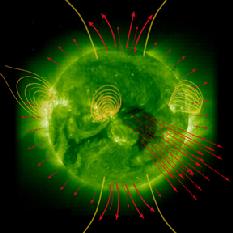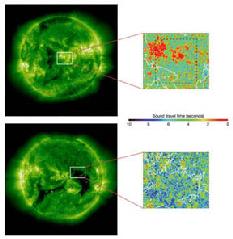Deep Roots of the Solar Wind
Click on either image for larger version | |
The Sun's atmosphere is threaded with magnetic fields (yellow lines). Areas with closed magnetic fields give rise to slow, dense solar wind (short, dashed, red arrows), while areas with open magnetic fields -- so-called "coronal holes" -- yield fast, less dense solar wind streams (longer, solid, red arrows). In addition to the permanent coronal holes at the Sun's poles, coronal holes can sometimes occur closer to the Sun's equator, as shown here just right of center. Image Credit: 2003 September 18 image from the SOHO Extreme ultraviolet Imaging Telescope (EIT). ESA/NASA | Sampling an area of the Sun's upper atmosphere (shown approximately by the white outlines on the full Sun images at left), McIntosh and Leamon used measurements made by NASA's TRACE spacecraft of a region with strong, closed magnetic fields on July 7, 2003 (top) and another region with weaker, open magnetic field on September 18, 2003 (bottom). The areas in red in the top "time difference" image show a shallow, dense chromosphere beneath an area with slow, dense solar wind outflow; the areas in blue in the bottom image show a deep, less dense chromosphere below a "coronal hole" with fast, tenuous solar wind outflow. Image Credit: Images on left from the SOHO Extreme ultraviolet Imaging Telescope - ESA/NASA; images on the right from The Astrophysical Journal - University of Chicago Press |
Using time series of images of the solar chromosphere from the TRACE Small Explorer spacecraft and solar wind data from the ACE spacecraft, two young solar physicists have come to a surprising conclusion: the speed and composition of the solar wind emerging from a given area of the solar corona can be estimated from the characteristics of the chromosphere underlying that piece of corona.
Using SOHO's Exteme ultraviolet Imaging Telescope (EIT) as a "finder," Scott McIntosh of the Southwest Research Institute (Boulder, Colorado) and Bob Leamon of L-3 Government Systems, working at NASA's Goddard Space Flight Center (Greenbelt, Maryland) isolated regions of the solar corona wirh open magnetic field lines (coronal holes) and closed fields (active regions). Then, using the earth-orbiting TRACE to measure the time sound waves took to travel between the heights of formation of two chromospheric continuua, they were able to demonstrate that that sound travel time predicted not only solar wind speed measured by ACE but its isotopic compositon as well. ACE, like SOHO, is in an orbit about the L1 Lagrange point,about 1% of the distance from the earth to the Sun. Thus ACE samples the solar wind near the earth, and just upstream of it.
Since the conditions in the ambient solar wind determine whether a coronal mass ejection (CME) will drive a shock wave in front of it, and shocks accelerate most of the energetic particles that can damage spacecraft and endanger spacefarers unshielded by a planetary magnetosphere, knowing the state of the solar wind throughout the heliosphere is essential to the exploration of the solar system. This work could extend solar wind predictions from the earth-Sun line (where ACE, WIND, and SOHO measure solar wind parameters) and a few planetary probes (such as the Voyagers) that also carry solar wind plasma packages, to cover the half of the heliosphere influenced by the visible hemisphere of the Sun.
While TRACE images the Sun with 5 times the resolution of EIT, it can cover only a fraction of the solar surface in a single image. NASA's Solar Dynamics Observatory (SDO), scheduled to launch in 2008, will carry the Advanced Imaging Array, an instrument capable of imaging the Sun with TRACE's superior resolution and EIT's whole-Sun field of view.
Related links
- Deep Roots of the Solar Wind
(NASA Exploring the Universe portal)
- The Astrophysical Journal (2005 May 10, Volume 624, p. L117)
Contact:
- Scott McIntosh
Southwest Research Institute, Boulder, Colorado USA
Phone: +1 (720) 240-0120
Fax: +1 (303) 546-9687- Bob Leamon
NASA Goddard Space Flight Center, Greenbelt, Maryland USA
Phone: +1 (301) 286-8958
Fax: +1 (301) 286-0264 - Bob Leamon
Spacecraft: TRACE (Transition Region And Coronal Explorer); ACE (Advanced Composition Explorer); SOHO (SOlar and Heliospheric Observatory).




